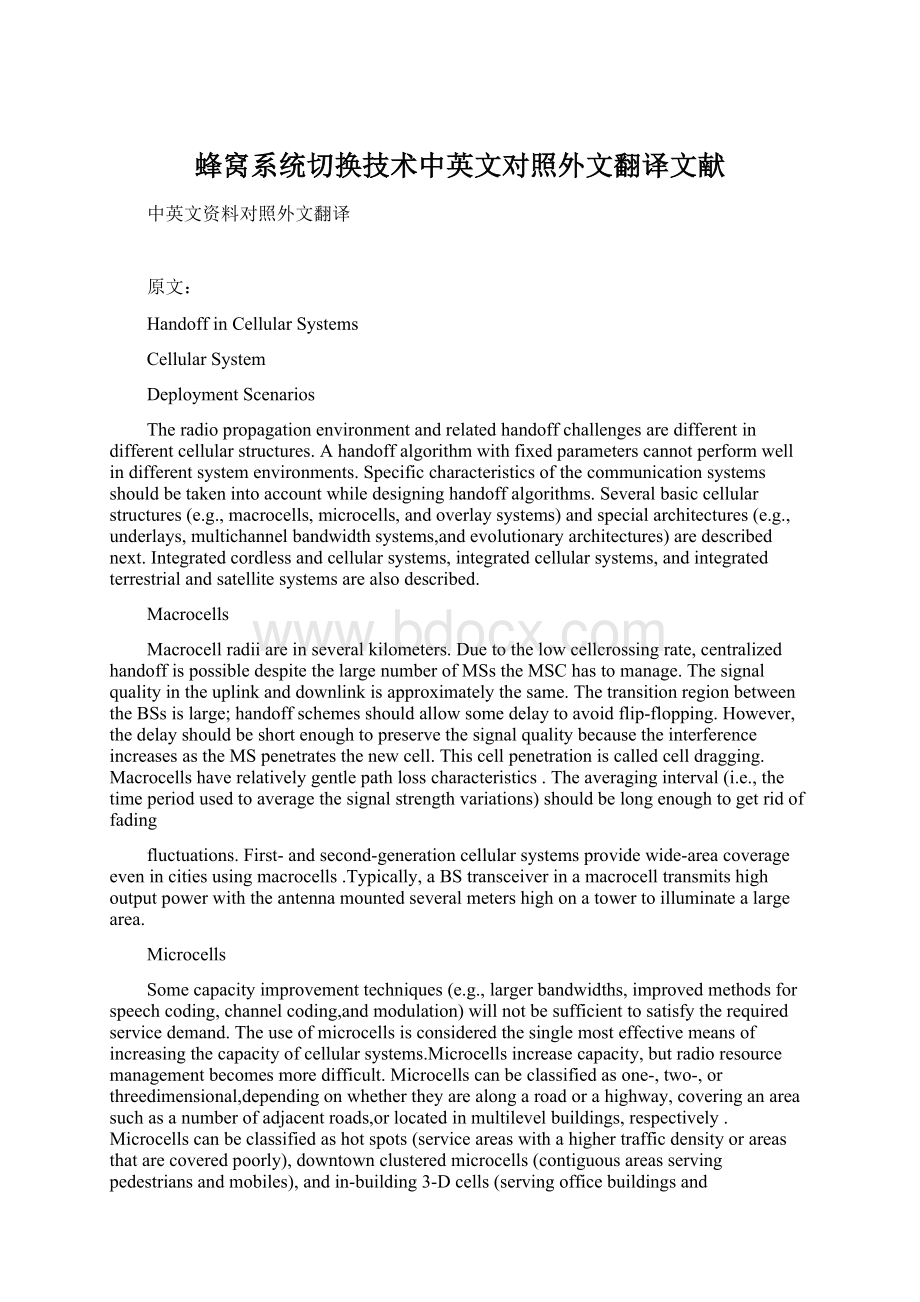蜂窝系统切换技术中英文对照外文翻译文献.docx
《蜂窝系统切换技术中英文对照外文翻译文献.docx》由会员分享,可在线阅读,更多相关《蜂窝系统切换技术中英文对照外文翻译文献.docx(11页珍藏版)》请在冰豆网上搜索。

蜂窝系统切换技术中英文对照外文翻译文献
中英文资料对照外文翻译
原文:
HandoffinCellularSystems
CellularSystem
DeploymentScenarios
Theradiopropagationenvironmentandrelatedhandoffchallengesaredifferentindifferentcellularstructures.Ahandoffalgorithmwithfixedparameterscannotperformwellindifferentsystemenvironments.Specificcharacteristicsofthecommunicationsystemsshouldbetakenintoaccountwhiledesigninghandoffalgorithms.Severalbasiccellularstructures(e.g.,macrocells,microcells,andoverlaysystems)andspecialarchitectures(e.g.,underlays,multichannelbandwidthsystems,andevolutionaryarchitectures)aredescribednext.Integratedcordlessandcellularsystems,integratedcellularsystems,andintegratedterrestrialandsatellitesystemsarealsodescribed.
Macrocells
Macrocellradiiareinseveralkilometers.Duetothelowcellcrossingrate,centralizedhandoffispossibledespitethelargenumberofMSstheMSChastomanage.Thesignalqualityintheuplinkanddownlinkisapproximatelythesame.ThetransitionregionbetweentheBSsislarge;handoffschemesshouldallowsomedelaytoavoidflip-flopping.However,thedelayshouldbeshortenoughtopreservethesignalqualitybecausetheinterferenceincreasesastheMSpenetratesthenewcell.Thiscellpenetrationiscalledcelldragging.Macrocellshaverelativelygentlepathlosscharacteristics.Theaveraginginterval(i.e.,thetimeperiodusedtoaveragethesignalstrengthvariations)shouldbelongenoughtogetridoffading
fluctuations.First-andsecond-generationcellularsystemsprovidewide-areacoverageevenincitiesusingmacrocells.Typically,aBStransceiverinamacrocelltransmitshighoutputpowerwiththeantennamountedseveralmetershighonatowertoilluminatealargearea.
Microcells
Somecapacityimprovementtechniques(e.g.,largerbandwidths,improvedmethodsforspeechcoding,channelcoding,andmodulation)willnotbesufficienttosatisfytherequiredservicedemand.Theuseofmicrocellsisconsideredthesinglemosteffectivemeansofincreasingthecapacityofcellularsystems.Microcellsincreasecapacity,butradioresourcemanagementbecomesmoredifficult.Microcellscanbeclassifiedasone-,two-,orthreedimensional,dependingonwhethertheyarealongaroadorahighway,coveringanareasuchasanumberofadjacentroads,orlocatedinmultilevelbuildings,respectively.Microcellscanbeclassifiedashotspots(serviceareaswithahighertrafficdensityorareasthatarecoveredpoorly),downtownclusteredmicrocells(contiguousareasservingpedestriansandmobiles),andin-building3-Dcells(servingofficebuildingsandpedestrians).Typically,aBStransceiverinamicrocelltransmitslowoutputpowerwiththeantennamountedatlamppostlevel(approximately5maboveground).TheMSalsotransmitslowpower,whichleadstolongerbatterylife.SinceBSantennashavelowerheightscomparedtothesurroundingbuildings,RFsignalspropagatemostlyalongthestreets.Theantennamaycover100–200mineachstreetdirection,servingafewcityblocks.Thispropagationenvironmenthaslowtimedispersion,whichallowshighdatarates.
Microcellsaremoresensitivetothetrafficandinterferencethanmacrocellsduetoshort-termvariations(e.g.,trafficandinterference
variations),medium/long-termalterations(e.g.,newbuildings),andincrementalgrowthoftheradionetwork(e.g.,newBSs).Thenumberofhandoffspercellisincreasedbyanorderofmagnitude,andthetimeavailabletomakeahandoffisdecreased.Usinganumbrellacellisonewaytoreducethehandoffrate.Duetotheincreaseinthemicrocellboundarycrossingsandexpectedhightrafficloads,ahigherdegreeofdecentralizationofthehandoffprocessbecomesnecessary.
Microcellsencounterapropagationphenomenoncalledthecornereffect.Thecornereffectischaracterizedbyasuddenlargedrop(e.g.,20–30dB)insignalstrength(e.g.,at10–20mdistance)whenamobileturnsaroundacorner.
Thecornereffectisduetothelossofthelineofsight(LOS)componentfromtheservingBStotheMS.Thecornereffectdemandsafasterhandoffandcanchangethesignalqualityveryfast.Thecornereffectishardtopredict.Alongmeasurementaveragingintervalisnotdesirableduetothecornereffect.MovingobstaclescantemporarilyhinderthepathbetweenaBSandanMS,whichresemblesthecornereffect.ReferencestudiesthepropertiesofsymmetricalcellplansinaManhattan-typeenvironment.Cellplansaffectsignal-to-interferenceratio(SIR)performanceintheuplinkanddownlinksignificantly.Symmetricalcellplanshavefournearestco-channelBSslocatedatthesamedistance.Suchcellplanscanbeclassifiedintohalf-square(HS),full-square(FS),andrectangular(R)cellplans.Thesecellplansaredescribednext.
Half-SquareCellPlan—ThiscellplanplacesBSswithomnidirectionalantennasateachintersection,andeachBScovershalfablockinallfourdirections.Thiscellplanavoidsthestreetcornereffectandprovidesthehighestcapacity.ThiscellplanhasonlyLOShandoffs.Figure2showsanexampleofahalf-squarecellplaninamicrocellularsystem.
Full-SquareCellPlan—ThereisaBSwithanomnidirectionalantennalocatedateveryotherintersection,andeachBScoversablockinallfourdirections.ItispossibleforanMStoexperiencethestreetcornereffectforthiscellplan.TheFScellplancanhaveLOSorNLOShandoffs.Figure3showsanexampleofafullsquarecellplaninamicrocellularsystem.
RectangularCellPlan—EachBScoversafractionofeitherahorizontalorverticalstreetwiththeBSlocatedinthemiddleofthecell.Thiscellplancaneasilybeadaptedtomarketpenetration.FewerBSswithhightransmitpowercanbeusedinitially.Asuserdensityincreases,newBSscanbeaddedwithreducedtransmitpowerfromappropriateBSs.Thestreetcornereffectispossibleforthiscellplan.TheRcellplancanhaveLOSorNLOShandoffs.Figure4showsanexampleofarectangularcellplaninamicrocellularsystem.Macrocell/MicrocellOverlaysCongestionofcertainmicrocells,thelackofserviceofmicrocellsinsomeareas,andhighspeedofsomeusersaresomereasonsforhigherhandoffratesandsignalingloadformicrocells.Toalleviatesomeoftheseproblems,amixed-cellarchitecture(calledanoverlay/underlaysystem)consistingoflargesizemacrocells(calledumbrellacellsoroverlaycells)andsmall-sizemicrocells(calledunderlaycells)canbeused.Figure5illustratesanoverlaysystem.
Themacrocell/microcelloverlayarchitectureprovidesabalancebetweenmaximizingthenumberofusersperunitareaandminimizingthenetworkcontrolloadassociatedwithhandoff.Macrocellsprovidewide-areacoveragebeyondmicrocellserviceareasandensurebetterintercellhandoff.Microcellsprovidecapacityduetogreaterfrequencyreuseandcoverareaswithhightrafficdensity(calledhotspots).Examplesofhotspotsincludeanairport,arailwaystation,oraparkinglot.Inlesscongestedareas(e.g.,areasbeyondacitycenteroroutsidethemainstreetsofacity)trafficdemandisnotveryhigh,andmacrocellscanprovideadequatecoverageinsuchareas.MacrocellsalsoservehighspeedMSsandtheareasnotcoveredbymicrocells(e.g.,due
tolackofchannelsortheMSbeingoutofthemicrocellrange).Also,afterthemicrocellularsystemisusedtoitsfullestextent,theoverflowtrafficcanberoutedtomacrocells.Oneoftheimportantissuesfortheoverlay/underlaysystemisthedeterminationofoptimumdistributionofchannelsinthemacrocellsandmicrocells.
Referenceevaluatesfourapproachestosharingtheavailablespectrumbetweenthetwotiers.Approach1usesTDMAformicrocellandCDMAformacrocell.Approach2usesCDMAformicrocellandTDMAformacrocell.Approach3usesTDMAinbothtiers,whileapproach4usesorthogonalfrequencychannelsinbothtiers.Theoverlay/underlaysystemhasseveraladvantagesoverapuremicrocellsystem:
•TheBSsarerequiredonlyinhightrafficloadareas.Sinceitisnotnecessarytocoverthewholeserviceareawithmicrocells,infrastructurecostsaresaved.
•Thenumberofhandoffsinanoverlaysystemismuchlessthaninamicrocellsystembecausefast-movingvehiclescanbeconnectedtotheoverlaymacrocell.
•BothcallingfromanMSandlocationregistrationcaneasilybedonethroughthemicrocellsystem.Thereareseveralclassesofumbrellacells.Inoneclass,orthogonalchannelsaredistributedbetweenmicrocellsandmacrocells.Inanotherclass,microcellsusechannelsthataretemporarilyunusedbymacrocells.Inyetanotherclass,microcellsreusethechannelsalreadyassignedtomacrocellsanduseslightlyhighertransmitpowerlevelstocounteracttheinterferencefromthemacrocells.
Withintheoverlay/underlaysystemenvironment,fourtypesofhandoversneedtobemanaged[19]:
microcelltomicrocell,microcelltomacrocell,macrocelltomacrocell,andmacrocelltomicrocell.Referencedescribescombinedcellsplittingandoverlaying.Reuseofchannelsinthetwocellsisdonebyestablishinganoverlaidsmallcellservedbythesamecellsiteasthelargecell.Smallcellsreusethesplitcell’schannelsbecauseofthelargedistancebetweenthesplitcellandthesmallinnercell,whilethelargecellcannotreusethesechannels.Overlaidcellsareapproximately50percentmorespectrallyefficientthansegmenting(theprocessofdistributingthechannelsamongthesmall-andlargesizecellstoavoidinterference).Apracticalapproachforimplementationofamicrocellsystemoverlaidwithanexistingmacrocellsystemisproposedin.Thisreferenceintroduceschannelsegregation(aself-organizeddynamicchannelassignment)andautomatictransmitpowercontrol